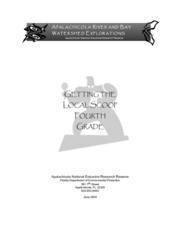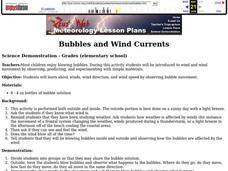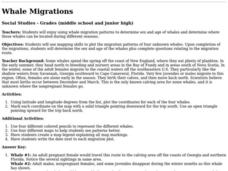Curated OER
Getting the Local Scoop
Fourth graders practice interviewing professionals in their area about their careers at a local watershed. They identify at least three careers that depend on the watershed and discuss its history. They write a composition to end the...
Curated OER
Hurricanes in History:
Students interpret data displayed in a graph, make inferences based on graphical data. They work in pairs or groups to interpret graphs containing historical data of hurricanes, and then answer questions that assess their understanding...
Curated OER
Wetland Wonders
Young scholars describe the characteristics of wetlands. They demonstrate their understanding of the importance of wetlands to humans and wildlife and determine they are defined by the presence of water, and specialized soils.
Curated OER
Along Our Coast
Students explore the coast lines of Florida. They examine the benefits of estuaries and examine the estuary systems found along the coast. Students research and construct a saltwater food web.
Curated OER
Introduction to Organisms of the St. Mary's River
Students identify how the tank functions, what organisms are in the tank, and why each component of the tank is important. They are introduced to the organism eelgrass. Students explore the organism Fundulus.
Curated OER
A Green Patina Finish
Students create a blue-green patina that serves as a protective coating on copper jewelry or other artwork. Using four different experimental methods, students apply patina to copper pieces and compare the results of the different...
Curated OER
When is Dinner Served? Predicting the Spring Phytoplankton Bloom in the Gulf of Maine (College Level)
Students are able to explain the ecological importance of phytoplankton. They describe the components that influence a phytoplankton bloom. Students interpret satellite images in order to correlate buoy data.
Curated OER
Harmful Algal Blooms in Full Bloom
Students calculate the total percentage of samples from the data on the graphs. In this marine science lesson, students analyze the concentration levels over a period of time. They suggest ways to lessen the effect of these blooms.
Curated OER
Pipeline to the Coral Reefs
High schoolers discuss the relationship of density to stratification. In this marine science lesson, students create a model of upwelling events using cold and warm water. They discuss how water phenomena affect coral reefs.
Curated OER
Ring Detectives
Pupils describe the overall flow of the Gulf Stream, and explain how it affects biological communities in the North Atlantic Ocean.Students describe Gulf Stream rings, and explain how they are formed.Pupils be abl
Curated OER
Who's Your Neighbor?
Pupils recognize and identify some of the fauna groups found in deep-sea coral reef communities. They describe common feeding strategies used by benthic animals in deep-sea coral reef communities.Students be able
Curated OER
Preparation -- The Right Way to Help and FOrm for Poetic Reflection
Students prepare for their service learning project by listening to a representative from the Lake Michigan Federation. They volunteer their time to clean up the coast line. They reflect on the event by writing a poem about their...
Curated OER
Sunken Hazard
Students use information about past oil spills to predict potential effects of the Prestige spill on the environment, on marine life, and on the human culture and economy of Spain.
Curated OER
Wetlands/Watershed Model
Learners make a model that will demonstrate the flow of surface water across the land in Texas and how materials that originate many miles away can end up in the wetland along the coast.
Curated OER
Bubbles and Wind Currents
Students are introduced to wind and wind movement by observing, predicting, and experimenting with simple materials.
Curated OER
Is There Seaweed/Algae in Your Food?
Young scholars discover that seaweed/algae is a small part of the resources the oceans provide. By investigating common household products, students discover that human senses are not enough to detect the presence of seaweed/algae in food.
Curated OER
Whale Migrations
Pupils use whale migration patterns to determine sex and age of whales and determine where these whales can be located during different seasons. They use mapping skills to plot the migration patterns of four unknown whales.
Curated OER
Learning from history: can it save lives?
Students research and document lessons learned from this disaster, then compile and synthesize information. They write effectively for public education purposes and use visual communications tools
Curated OER
E-Pal Adventure
Eighth graders develop online writing relationships with students from another area in their state. They write weekly regarding assigned topics, including researching information about the area in which they live.
Curated OER
Endangered Species Scavenger Hunt
Seventh graders gain a better understanding of endangered species. This lesson requires a field trip to the North Carolina Zoological park. At the park, 7th graders use a worksheet imbedded in this plan to identify and categorize the...
Curated OER
Land Use and Nitrogen
Students consider the effects of development on water quality. They test nitrogen levels in waters before and after development, investigate wastewater treatment options and research best management practices to reduce nitrogen loads.
Curated OER
Tracking a Hurricane
Students use knowledge of what satellite imagery tells to create a descriptive hypothesis of the ground phenomenon during a hurricane.
Curated OER
Loss of Wetlands: Subsidence
Students observe subsidence and the effect it has on wetlands with a classroom demonstration. They think about the impact of global warming and the sea level and how it affects the marsh.
Curated OER
Fenwick Island, Maryland And Beyond: Who Owns the Sand?
Students examine beach processes and complex beach systems. They study the human efforts to stabilize an unstable environment can lead to complex problems.
Other popular searches
- Coastal Erosion
- Coastal Zones
- North Carolina Coastal Plain
- Coastal Management
- Coastal Plants and Animals
- Coastal Climate
- Coastal American Indians
- Coastal Change Analysis
- Coastal Monitoring
- Coastal Ecosystems
- Coastal Area
- Coastal and Marine Resources























